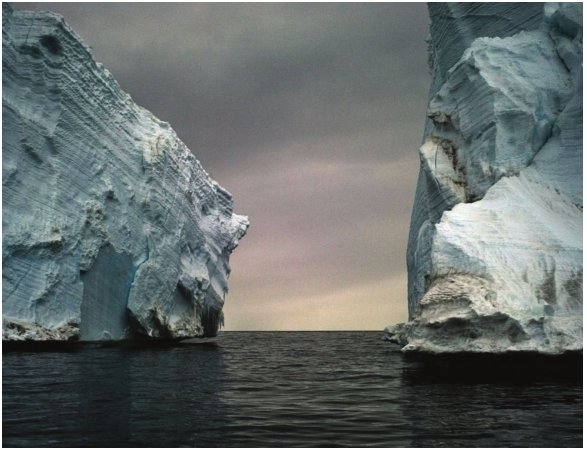
“My relationship with my fear is very different than most people’s,” Seaman said. “I tend to lean in toward my fear rather than be repulsed by it. I am always self-analyzing. Why am I afraid? What am I really afraid of?”
“All My Relations: An Indigenous Perspective on Landscape,” an exhibition of Seaman’s work, opens Monday at the MSU Museum. The exhibit includes photos from three photography series, “Melting Away” and “The Last Iceberg,” which explore the Arctic and Antarctic regions, and “The Big Cloud,” which documents her storm chasing work.
“I was just really awestruck by the beauty and the fact that these forces that are at play on our planet are both so beautiful and so terrifying,” she said. “So constructive and destructive. They are so visually stunning, yet most people go the other way to avoid seeing them.”
“All My Relations,” as well as “Next Stop Atlantic,” a photography exhibit by Stephen Mallon, are the MSU Museum’s contribution to the “Water Moves MSU Initiative.” The campuswide, multi-disciplinary initiative aims to draw attention to the world’s aquatic habitats and the changes to them caused by human influence.
Seaman’s work in the Arctic and Antarctic covers everything from the “perpetually changing” faces of glaciers to the debris and “minutia” left behind by animals and humans.
The project spans 12 years, including Seaman’s most recent trip to the Antarctic in January 2016.
Seaman’s storm-chasing work was a long-term project as well, lasting eight years. During that time, she photographed a variety of storms, including the largest tornado in recorded history, El Reno, which spanned nearly 3 miles in diameter. The work was inspired by both her daughter’s interest in storms, as well as her Shinnecock Native American heritage.
When asked if she considered herself an environmental photographer, Seaman said that she feels all photography fits that mold in some way.
“I think that because of my indigenous upbringing and my perspective of connectedness and that everything is related, there’s no environmental. It is the same thing as portraiture; they’re all connected,” Seaman said. “I’m hoping that the work becomes personal to people, that they understand that this is their planet that they are a part of. That they share DNA with most of the life forms and creatures on this planet, that humans are not separate from nature. To say that the environment is somehow separate from social issues is, I think, at our own peril.”
Howard Bossen, professor of photography and visual communication at MSU and an adjunct curator at the MSU Museum, said that Seaman’s unique take on her subjects is why he picked her work.
“Camille’s work is different in the sense that there are a lot of people who have photographed the Arctic and the Antarctic, and there are a lot of people who have photographed big storms, but there are very few people who have photographed either of those subjects as beautifully, as powerfully as she has,” Bossen said. “It’s different. I think part of the difference is she brings the influence of her Shinnecock culture to it.”
Seaman will host two public talks at MSU this month. The first, March 26 at the MSU Museum, will focus on her exhibition.
“I hope that people gain a better understanding of why she chose to photograph these subjects, how she went about actually making them, being on icebreakers for weeks on end — communication and things like that, how you actually make photographs when your equipment can start freezing in a few minutes,” Bossen said.
The second talk, March 29 at the College of Communication Arts and Sciences building, will discuss Seaman’s work photographing the Dakota Access Pipeline protests at Standing Rock.
“She’s going to put that into context of indigenous rights to water, the sacredness of water to her culture.”
Seaman said she hopes her unique perspective, rooted both in indigenous and Western culture, will help to give insight on the state of the planet.
“It’s a very dangerous time, and it’s almost more important than ever to show how beautiful our planet is, to show how beautiful life can be here and remind people that these things are not to be taken for granted,” Seaman said. “We only get one Earth, and I’m not interested in moving to Mars.”
“All My Relations: An Indigenous Perspective on Landscape”FREE March 20–Sept. 29 Main Gallery, MSU Museum 409 W. Circle Drive, East Lansing (517) 355-2370, museum.msu.edu
Photography talk with Camille SeamanFREE Sunday, March 26, 2017 2-3 p.m. MSU Museum 409 W. Circle Drive, East Lansing (517) 355-2370, museum.msu.edu
Standing Rock: Talk with Photographer Camille SeamanFREE Wednesday, March 29, 2017 3-4:20 p.m. Communication Arts and Sciences, room 145 404 Wilson Road, East Lansing
Support City Pulse - Donate Today!
Comments
No comments on this item Please log in to comment by clicking here